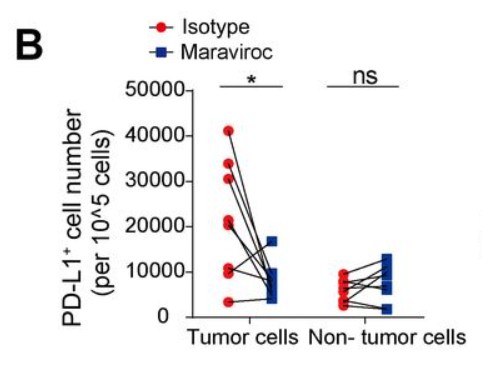(Total Views: 612)
Posted On: 05/15/2025 2:36:38 AM
Post# of 157400
A little info on CCR5 and PDL-1
non-maraviroc
From Dr. Pestell himself -
Quote:
CCR5 blockade inflames antitumor immunity in BAP1- mutant clear cell
renal cell carcinoma
https://jitc.bmj.com/content/jitc/8/1/e000228.full.pdf

Quote:
Moreover, our analysis of the TCGA-PRAD dataset showed a significant positive correlation between CCR5 and PD-L1 (Figure 7G). This led us to investigate whether CCL5 induces PD-L1 expression via the AKT pathway upon binding to CCR5. Rescue experiments were conducted using the CCR5 antagonist MVC and the AKT inhibitor MK-2206. The findings revealed that both MVC and MK-2206 effectively suppressed the expression of PD-L1 induced by CCL5 (Figures 7H–7J). These results suggest that CCL5 plays a crucial role in the transcription of PD-L1 in PCa and that the inhibition of CCR5 by MVC and AKT by MK-2206 can impede this process. In conclusion, CAFs have the potential to activate the AKT pathway through the CCL5-CCR5 paracrine axis, leading to the upregulation of PD-L1 expression in PCa and subsequent immune evasion.
Cancer-associated fibroblasts promote enzalutamide resistance and PD-L1 expression in prostate cancer through CCL5-CCR5 paracrine axis
https://www.cell.com/iscience/fulltext/S2589-...896-4#fig7
non-maraviroc
Quote:
Macrophage-derived CCL5 facilitates immune escape of colorectal cancer cells via the p65/STAT3-CSN5-PD-L1 pathway
C-C motif chemokine ligand 5 (CCL5), which is secreted by macrophages, inhibited T-cell-mediated killing of HT29 cells and promoted immune escape by stabilizing PD-L1 in vitro and in vivo. Mechanistically, CCL5 resulted in formation of nuclear factor kappa-B p65/STAT3 complexes, which bound to the COP9 signalosome 5 (CSN5) promoter, leading to its upregulation. Moreover, CSN5 modulated the deubiquitination and stability of PD-L1. High expression of CSN5 in CRC was associated with significantly shorter survival. Furthermore, compound-15 was identified as an inhibitor of CSN5, and destabilized PD-L1 to alleviate the tumor burden. Our results suggest that the novel CCL5-p65/STAT3-CSN5-PD-L1 signaling axis is significantly activated by LPS or HCD-driven macrophage infiltration in an animal model of CRC, which likely has therapeutic and prognostic implications for human cancers.
Insert-tag-here
Quote:
CCR5 and CCL5 in metastatic colorectal cancer
They demonstrated that high expression of CCR/L5 was associated with infiltration by negatively prognostic Tregs, M1 and M2 macrophages, myeloid-derived suppressor cells, and cancer-associated fibroblasts. They also showed that increased expression was correlated a wide variety of immune suppressive proteins, including PD-1, PD-L1, PD-L2, CTLA4, CD80, CD86, TIM3, IDO1, LAG3, and IFN-γ. This suggests mechanisms by which CRC resists anti-cancer immune responses. This study enhances our understanding of the role of the CCR/L5 axis in advanced CRC.
https://jitc.bmj.com/content/12/5/e008722
From Dr. Pestell himself -
Quote:
CCR5 plays a pivotal role when expressed in breast cancers in facilitating tumor progression and metastasis in multiple ways. CCR5 stimulates tumor angiogenesis and induces tumor-cell-forming circulating tumor cells, which allow the tumor cells to spread to a distant site. CCR5 mediates tumor cell glucose uptake, which aids in tumor growth. The CCR5-CCL5 axis allows cancer cells to escape the immune system through the reprogramming of TAMs to become M2 macrophages and enhances the expression of PD-L1. CCR5 promotes resistance to chemotherapy through the stimulation of the DNA repair machinery and enhancement of anti-apoptotic mechanisms. CCR5 antagonists such as leronlimab, maraviroc, and vicriviroc have been shown to reduce the impact of CCR5 on tumor progression and halt the metastatic process.
https://www.mdpi.com/2073-4409/12/18/2237
